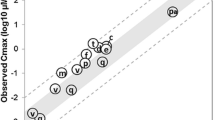Abstract
Purpose. Peak drug concentration (Cmax) measures the extremity of drug exposure and is a secondary indicator of the extent of absorption after area under the concentration time curve (AUC). Cmax serves as the indicator of absorption rate in bioequivalence (BE) studies in the US (1). The use of Cmax, not the time to Cmax(Tmax), as the metric to assess absorption rate causes erratic inferences in BE studies, and incorrect conclusions for some. We can improve BE efficiency (i.e., get the answer right the first time), by properly analyzing the time to Cmax(Tmax) instead of Cmax.
Methods. We have previously redirected attention to Tmax as the unconfounded absorption rate variable, instead of Cmax, and have called for equally spaced sampling times during the suspected absorption phase to improve the performance of the rate metric (2). Equal spacing converts Tmax easily into a count variable and we illustrated an appropriate statistical analysis for counts. This paper provides some measurement theory concepts to help judge which is the more appropriate analysis, and also provides parametric confidence limits for Tmax treatment differences. Three separate BE studies are then analyzed by both methods.
Results. By focusing on the differences in conclusions, or inferences, this paper identifies three major issues with the current FDA "recommended” analysis of BE studies. First, Cmax, a continuous variable peak-height or extent measure has usurped Tmax's function and performs erratically as a substitute measure for the rate of absorption. Second, Tmax, should be analyzed as a discrete attribute, not as a continuous variable. Third, since several extent measures (AUC, Cmax), not one, are actually being analyzed, an adjustment for multiple testing is mandatory if we are to maintain the size of the test at the desired α level (13), and not inadvertently use a narrower bioequivalence window than is intended. These actions all can have serious unintended consequences on inferences, including making inappropriate ones.
Similar content being viewed by others
REFERENCES
Division of Bioequivalence Guidance Statement. Statistical procedures for bioequivalence studies using a standard two-treatment crossover design. Office of Generic Drugs, Food and Drug Administration, Rockville MD, 1992, pp. 1–13.
R. P. Basson, B. J. Cerimele, K. A. DeSante, and D. C. Howey. Pharmaceutical Research, 13:324–328. 1996.
W. Feller. An Introduction to Probability Theory and its Applications. 2nd edition. John Wiley and Sons, New York, 1957, pp. 135–163.
W. S. Sarle. Measurement Theory: Frequently asked questions. Disseminations of the International Statistical Applications Institute, 4th Edition, ACG Press, Inc., Wichita KS, 1:pp. 61–66. 1995.
P. McCullagh and J. A. Nelder. Generalized Linear Models. Chapman and Hall, London, 1989.
SAS Institute: SAS/STAT ™ Software: The Genmod Procedure, Release 6.09. SAS Institute, Cary, NC, pp. 1–88. 1993.
Cytel Software Cor.: StatXact. Statistical Software for Exact Non-parametric Inference, Cytel Software Corp., Cambridge, MA 02139, Chapter 4. 1991.
W. J. Westlake Bioavailability and bioequivalence of pharmaceutical formulations. In: K. E. Peace (eds.), Biopharmaceutical Statistics for Drug Development, Marcel Dekker, New York, pp. 329–352. 1988.
D. J. Schuirmann. J. Pharmacokin. Biopharm. 15:657–680. 1987.
SAS Institute: SAS/STAT ™ User's Guide, Release 6.3 Edition. SAS Institute, Cary, NC, 1988, pp. 549–640.
SAS Institute: SAS ™ Technical Report, SAS/STAT™ Software: Changes and Enhancements, Release 6.07, SAS Institute, Cary, NC, pp. 371–405. 1992.
H.-U. Schultz and V. W. Steinijans. Int. J. Clin. Pharmac. Ther. Toxic. 30(Suppl. 1), 1992, S1–S6.
P. H. Westphal and S. S. Young. Resampling-Based Multiple Testing: Examples and Methods for p-value Adjustment. Wiley-Interscience, New York, NY. 1993.
Author information
Authors and Affiliations
Rights and permissions
About this article
Cite this article
Basson, R.P., Ghosh, A., Cerimele, B.J. et al. Why Rate of Absorption Inferences in Single Dose Bioequivalence Studies are Often Inappropriate. Pharm Res 15, 276–279 (1998). https://doi.org/10.1023/A:1011974803996
Issue Date:
DOI: https://doi.org/10.1023/A:1011974803996




